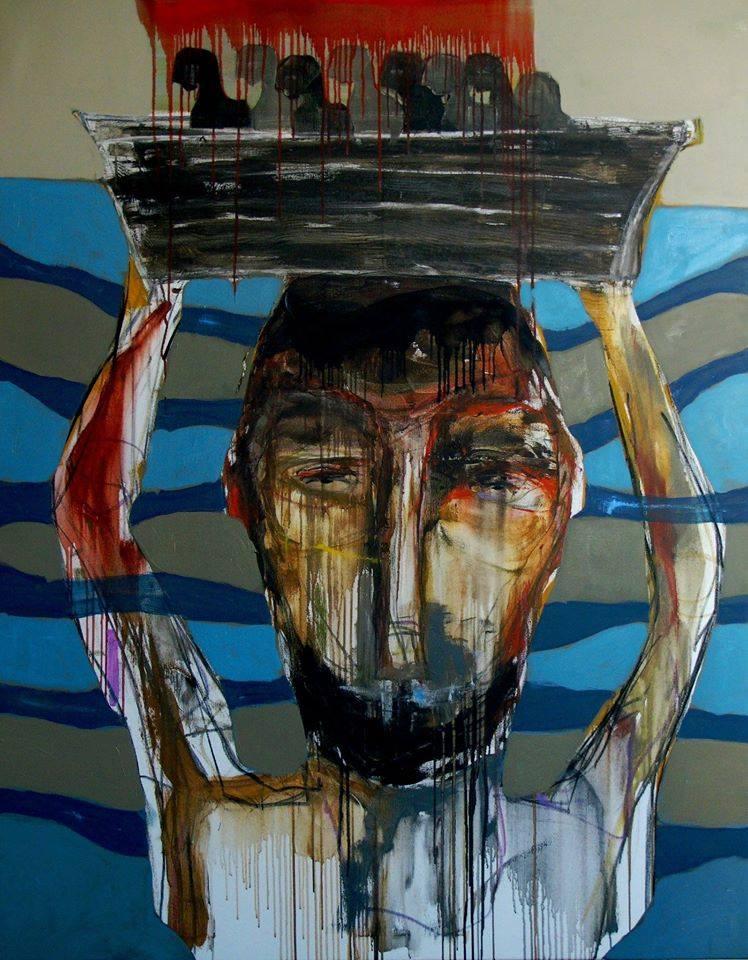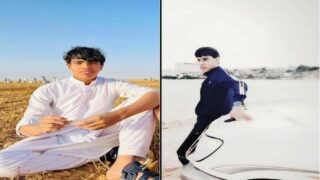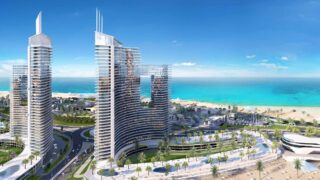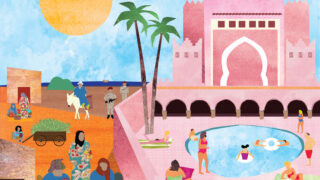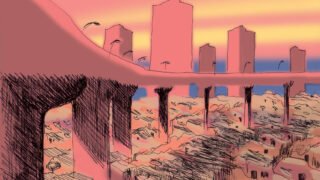
This publication has benefited from the support of the Rosa Luxemburg Foundation. This text may be reproduced in part or in full, provided the source is acknowledged.
Nothing in Sinai resembles anything elsewhere, not even the migrants. Indeed, in Sinai, migrants are more prone to suffering. Bones merge with steel and trafficking overlaps with slavery along the arduous journey in the desert. Many get killed on the road from East Sudan to Sinai. Migrants in different parts of the world are at risk of being murdered, of dying as a result of the harsh conditions they are subjected to, of being sexually exploited, blackmailed or taken as hostages. In the case of Sinai, the migrants - or the kidnapped- endure all of the above at the same time. The situation has prompted some in the worlds of academia and human rights to coin a new term in 2015: “Sinai Trafficking”.
The human trafficking to the North of Sinai began in 2009, when people were “stored” in border cities and, more precisely, in the South of Rafah and the town of Sheikh Zuweid. The journey starts in East Sudan where refugees’ camps are located. There, the traffickers seek to attract migrants or refugees who have fled their home countries because of wars, political oppressions, violence or hunger. Most of those refugees come from Eritrea and Ethiopia with the majority being Eritrean because of the political oppression, the extreme poverty and the indefinite military enlistment in their country of origin.
The trafficking route starts in East Sudan which is under the control of the Rachaida tribes and continues into the Eastern Sahara in Egypt, where other tribes are involved. Those migrants and refugees end up in warehouses in the North of Sinai hoping to get to Israel. In Sinai, members of the tribes of Sawarka, Tarabin and Ermilat handle the situation while members of the Azazmah tribe serve as linking pins with Israel due to their presence on both sides of the border.“The mingling of bones and steel” is the phrase that describes the human trafficking that is commonly combined with arms smuggling along the same journey and even inside the same containers. The crossing is more laborious during the baking hot months of summer when the risks of dying of thirst increase. Then, the steel continues its route and meets, in the desert, with the migrants whose bones remain as witnesses of the journey.
When Israel started to violently combat the arrival of both migrants and arms, the situation shifted from human smuggling to human trafficking. As the migrants became a burden to the smugglers, this trade witnessed a transformation in its nature by the end of 2010. The operations of abduction started in East Sudan, inside the United Nations refugees’ camps and in the nearby villages. The human smuggling and trafficking groups began to prosecute the fugitives from these camps, abduct them and send them to Sinai which has since become one of the biggest sites of slave trade of the new millennium. Those groups working in organized transboundary crime demanded ransoms with amounts ranging from three thousand to forty-thousand dollars. The Eritreans were the most expensive in this trade and Ethiopians were pressured into pretending to be Eritreans. It is unclear why the Eritreans were preferred to other nationalities in this trafficking process.
The trafficking route starts in East Sudan which is under the control of the Rachaida tribes and continues into the Eastern Sahara in Egypt, where other tribes are involved. Those migrants and refugees end up in warehouses in the North of Sinai hoping to arrive to Israel.
Those who are abducted are coerced into forced labor in the sectors of construction work, excavation, everyday services, and, sometimes, in hostilities and rivalry between the different tribes. The women, the men and sometimes the children are subjected to sexual exploitation and rape. Torture was divided into two types: the first one is functional and intended to pressure them to pay the ransom, while the second one falls into the category of sadistic violence as the abductors take joy in torturing those who have become their slaves. Many international reports have shown that those kidnapped are subjected to burning, brutal beating and electrocution. Some media reports have also highlighted the intermingling between human smuggling and organs trafficking, and the linkage of these operations with an organization in Cairo that has sophisticated medical capabilities and is suspected of harvesting human organs. No side or international organization could confirm this fact and researchers from Sinai have either denied it or admitted that it might have happened on very sparse and exceptional cases.
Human traffickers and soldiers
It is impossible for this long trafficking road to go its way without anyone noticing. Most of the international reports indicate the connivance and corruption of various components of the army and the police in Egypt and Sudan and their involvement in the trafficking networks. There are several stages in the human trafficking operations. Sometimes, the abducted ones are sold repeatedly along this journey or, after their families have paid their ransom, they are once again sold to another group and repeatedly exploited.
The security level owing to the issue of migrants, refugees and the kidnapped in Sinai is complicated for many reasons. The state cannot protect them and, besides the international human rights considerations, they have no legal support and become “worthless” whenever they are subjected to torture, sexual exploitation or killing. The connivance and corruption of the army and the police with the smugglers is most visible when confronted with the requirements for providing their safety and security. The different reports show that, on many occasions, when the victims have managed to escape from the smugglers and traffickers and have resorted to the security checkpoints, those security forces have handed them back to the smugglers. And, in other cases where the victims managed to escape the smugglers, they were detained in very harsh conditions without legal or psychological support (and this is a very important point, because most of them were subjected to torture, rape and very difficult experiences). The security forces also forbid them from making any contact with civil society institutions. They are faced with extortion once again as the security forces require that they gather the necessary amount of money for their repatriation which happens in conditions that are no less harsh than those of their first journey. The detention can last for long undetermined periods of time.
Where is the securitization? It can be found within the relation with Israel. Anything happening in Sinai, from North to South, is entrusted to one of the security bodies, or to several of them, and is engaged in complex relationships between the networks of security, crime, smuggling and terrorism… Sinai is one the most securitized zonesin the world. Everybody is scrutinizing it; everybody is fighting over its land. And, despite that, the North of Sinai is one of the most insecure parts of the world in terms of terrorism and human and drug trafficking and a territory for security and intelligence operations.
Some researchers have pointed out that the issue of migrants in Sinai has been securitized (transformed from a political and social problem to a security one). The operation of securitization happens according to various stages and calls for exceptional policing proceedings. But it appears that this was not the case for migrants in Sinai. Not only is there no methodical security discourse concerning the issue, but there is no discourse at all around the issue of migration in Egypt, be it by the security apparatuses or by the various media institutions. The problem is neither talked about nor is it ever discussed, except one single time, in 2012, when Naila Jaber, the president of the Committee to Combat Human Trafficking and Irregular Migration, recognized the issue in a meeting with “Human Rights Watch”.
Where is the securitization, then? It can be found within the relation with Israel. It has become a pressing security issue for Israel and the Egyptian state considers it as being a mutual security problem for both Egypt and Israel. Securitization generally derives from two things: firstly, it is a practice inherent to the successive Egyptian authorities, and secondly, there is no type of handling in Sinai outside the sphere of security interactions. Anything happening in Sinai, from North to South, is entrusted to one of the security bodies –or to several of them- and engaged in complex relationships between the networks of security, crime, smuggling and terrorism…
Some argue that the expansion of human trafficking and smuggling in Sinai happened because of the absence of security forces in the aftermath of 2011, but this, for many reasons, is untrue. First of all, trafficking in this region precedes the events of the Revolution of January and the collapse of the Egyptian police. Secondly, the revolution has not clashed with any of the following security apparatuses: General Intelligence, Military Intelligence and Border Guards which have all remained intact and in place. Their institutional establishments were untouched, while the only changes within them happened on the level of individuals. Thirdly, the whole thing was happening with the connivance of the different security forces.
The Egyptian authorities and the issue of the migrants in Sinai
In 2007, the Egyptian authorities created “the National Coordinating Committee for Combatting and Preventing Human Trafficking and Irregular Migration”. This committee presented a draft law to combat human trafficking to the Egyptian Parliament in 2009, which later adopted the Law 64 of 2010. Egypt adheres to most of the International Conventions related to human trafficking and the fight against smuggling and has joined many new treaties since 2004 after having ratified the Pact on Organized Crime. So, from a legal standpoint, Egypt has the tools to deal with this kind of issues. In 2011, the National Plan of Action to Combat Human Trafficking was approved and comprised four components: 1- preventing human trafficking, 2- protecting the victims of human trafficking and society as a whole, 3- prosecuting smugglers and traffickers, 4- cooperating on a national and international level to prevent human trafficking.
The crossing is more laborious during the baking hot months of summer when the risks of dying of thirst increase. Then, the steel continues its route and meets, in the desert, with the migrants whose bones remain as witnesses of the journey.
As the international reports describing the ugliness of the situation intensified in 2012 and with the continued connivance of members of the police and the army, the Egyptian authorities still denied their involvement in the operations of trafficking and smuggling. The investigation on the issue ended up declaring that most of the information were untrue, “and according to the public prosecutor, most of the bodies found were those of migrants who died from thirst”. In September 2012, Naila Jaber notified a civil society organization that she would consider that those allegations are part of a propaganda against Egypt if the names of the victims and information on them were not presented according to the report of the European Parliament.
The interesting part is that the Egyptian authority has managed to get support and funds for its project of combatting human trafficking and has held international and national civil society organizations responsible for the costs needed to train judges, prosecutors and security agents who lacked previous experience in the field. It has dealt with the issue in three distinct ways: turning a blind eye on the crisis and on the connivance of its security agents, permanently denying the crisis and transforming it into a security problem shared with Israel and, then, exploiting the issue to enhance the capacity of its personnel to deal with the problem.
On the interferences of the networks: terrorism, trafficking and security agencies.
Sinai is a geographically besieged peninsula, which is also under a tight security blockade. In the East, lies Israel which occupies the Palestinian territories, the Gulf of Aqaba and the Gaza Strip. In 2012, Israel installed barbed wires along its frontiers with Egypt. In the West, lies the Suez Canal and its Gulf, in the South the Mediterranean Sea and in the North the Red Sea. Peacemaking forces have come to Sinai after the Camp David Accord of 1987. Sinai is perhaps one of the most securitized zones of the world. It is scrutinized by the security agencies and the international order to guarantee the stability of the region and safeguard the peace agreement between Egypt and Israel. All the Egyptian security services and the different forces (the border guards, units of the Egyptian army, the general and military intelligences, the state security and the police forces) are present there. The influence of the Israeli security services also extends to Sinai, as well as Hamas, Fatah, and, sometimes, security components of Iran and Hezbollah can be found. Everybody observes Sinai; everybody is fighting over its land. Despite that, the North of Sinai is one of the most insecure parts of the world in terms of terrorism and human and drug trafficking and it is a territory for security and intelligence operations. Sinai is the biggest manifestation of the regional order which is part of the international one. Despite the amount of wealth amassed in it, Northern and Central Sinai are among the poorest regions, where development, medical services, educational services, electricity, water and nutrition are absent. In this situation, how can a commerce such as human trafficking and migrant smuggling grow? To answer this question, one must first define and chart the relationships among networks and understand the interferences, constructions and complications among them.
There is no life in Sinai outside of illegal commerce in all its diversity. The smuggling activity partly acts as a political economy that guarantees the financial sustainability of the region fostering its daily life.
So, what is the relationship between smuggling and security agencies, and between migrants and armed groups? There are agreements between some of the security men and the smugglers in exchange for money, and this lucrative business has allowed for the creation of massive wealth. Though, the issue is not limited to connivance and corruption.
Smuggling, its routes and tracks and the men involved in it are important issues for everyone. The security agencies (Egyptian and non-Egyptian ones) rely on the smugglers who know the roads. They exploit them in various operations, from espionage to the striking of other specific networks, and even in weapon-smuggling. There is no life in Sinai outside of illegal commerce, in all its diversity. The smuggling activity partly acts as a political economy that guarantees the financial sustainability of the region, fostering its daily life. Such is the case of drugs, be it because it is a main livelihood that contributes to the creation of tourism in the South, or because it is one of the means invested by the security agencies to spy and recruit men. More ominously, in those kinds of relations of power and conflict, the chances of a brutal transboundary corruption increase and the security components of different countries overlap in becoming partners in organized crime. This is what gives smugglers immunity and protection. It is therefore no coincidence that no member of the smugglers and human traffickers has ever been caught or brought to justice before the Egyptian courts on internationally and nationally prohibited grounds. Similarly, no member of the security apparatuses has ever been considered as a suspect, not even once.
The functions of the security apparatuses, their intelligence and espionage roles intersect with trafficking, poverty and corruption. All this creates the necessary conditions for an insecure situation despite the strong presence of all kinds of security and control agencies in Sinai. Therefore, the law is completely neutralized. The trafficking networks become an ideal device for the security agencies to infiltrate spaces, groups and communities that would have otherwise been difficult to penetrate through regular means. The various ways of trafficking and the presence of multiple networks allow the security agencies to block or trap certain networks or particular state apparatuses, either because of their rivalry or because of the lack of coordination among them. Thus, networks are created to strike others, and Sinai becomes one of the regions of the world where conflicts among security agencies is the most concentrated, inside the borders of the state and in transboundary ways, too.
It is no coincidence that no member of the smugglers or human traffickers has ever been caught or brought to justice before the Egyptian courts on internationally and nationally prohibited grounds. Similarly, no member of the security apparatuses has ever been considered as a suspect, not even once.
Armed groups add to all the previous components. A researcher from Sinai established the following points to better understand the relationship between traffickers and armed groups: 1- whoever, among the traffickers, is not part of an armed group, cooperates with them in exchange for money, and, sometimes, the members of a contraband network are also members of an armed group, 2- Cooperation exists between armed groups and security services so that the commerce of the smugglers, of any kind, doesn’t get disrupted, 3- Guaranteeing the smugglers’ work continuity without interference from “Al-Hisbah” forces of the Islamic State, 4- Kinship. The researcher indicates that the smugglers were the ones who facilitated the access of weapons and food for the armed groups during the different periods of besiegement.
It is possible to predict what is coming despite the complexity of the security situation in Sinai. Firstly, money governs all relationships, especially in the absence of sources of livelihood and given that the security apparatuses and some of their corrupt members, encourage the smuggling networks. Secondly, the number of networks increases with the multiplication of the attempts to penetrate and monitor, therefore, whenever the possibility of breaching increases, the volume of trade and smuggling grows as well as the interference between security, terrorism, social and economic situations.
Because organized crimes take the form of networks, contradicting elements can easily be found inside them. It is possible for the member of a network, or even for its leaders, to be affiliated with the security agencies while others of the same network cooperate with armed groups. Also, elements from the Palestinian security apparatuses collude and turn a blind eye on human trafficking to ensure that the weapons will keep on flowing from Sudan. The unrest of Sudan, Libya and Eritrea contributes to the continuance of the flow of arms and to the abduction of people, especially that there is a high demand on arms, whose necessary funding is covered.
How did the trafficking and smuggling of people decrease in Sinai?
Did the intervention of the European Union, the reports of human rights organizations and the systemic campaigns really have an effect on reducing human trafficking and smuggling in Sinai? This assertion is not true and the decline of this trade had nothing to do with the humanitarian situation or the atrociousness of the committed crimes. As the international reports indicate a significant positive evolution, we can monitor the elements that led to the reduction, and perhaps the end, of this organized transboundary crime in Sinai after 2014.
Most likely, this was due to the following factors:
- By the year 2012, Israel managed to entirely close its eastern border with Egypt by completing the barbed wire barrier.
- During the same year, the operation “Eagle II” began to counter the armed groups there.
- The pressure that Israel put on Egypt to eradicate human smuggling to its territories.
- During the years 2013 and 2014, Sinai transitioned from a highly volatile security zone that fosters the growth of organized crime into a fierce battlefield between the terrorist groups and the state, which reduced movements and resulted in a relative downsizing of corruption inside the security agencies, because of the overlapping between human trafficking, smuggling and the arms trade.
- The unprecedented tunnels’ destruction and the closure of cross-border smuggling opportunities between Egypt and Israel.
- The displacement of border villages and cities starting from the year 2014.
- The completion of a buffer zone in Rafah and of the border strip after the resolution 203 of the year 2013: it is 14 km long and goes 5 km deep into Sinai.
- The escape of the smuggling lords outside of Sinai after having amassed large fortunes.
The content of this publication is the sole responsibility of Assafir Al-Arabi and Rosa Luxemburg Foundation cannot accept any liability for it.
Translated from Arabic by Fourate Chahal Rekaby
Published in Assafir Al-Arabi on 01/08/2018

